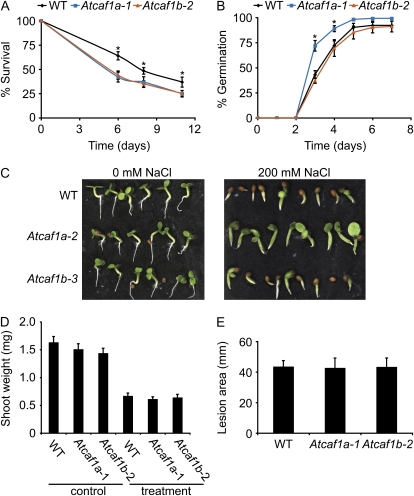Figure 7.
AtCAF1a and AtCAF1b mediate response to abiotic stresses. A, Survival of wild type (WT), Atcaf1a-1, and Atcaf1b-2 on 5 μm MV (paraquat). Data are means of nine independent biological replicates ±sem. Asterisks denote a significant difference of both Atcaf1a and Atcaf1b from wild type (P < 0.05) as determined by t tests. B, Germination of wild type, Atcaf1a-1, and Atcaf1b-2 on 200 mm NaCl. Data are means of four independent biological replicates ±sem. Asterisks denote a significant difference of Atcaf1a from wild type and Atcaf1b (P < 0.05) as determined by t tests. C, Wild type, Atcaf1a-2, and Atcaf1b-3 grown on either 0 mm NaCl for 2 d or 200 mm NaCl for 12 d. D, Waterlogging tolerance of wild type, Atcaf1a-1, and Atcaf1b-2. Three-week-old plants were submerged for 7 d and then allowed to recover for 5 d prior to measurement of fresh weight. Data are means of 32 independent biological replicates ±sem. E, Lesion area 4 d after spot inoculation with spores of B. cinerea isolate B05.10. Similar results were obtained using the B. cinerea isolate DN (data not shown). Data are means of 15 independent biological replicates ±sem. All abiotic and biotic stress-tolerance assays were independently repeated one to four times with similar results.

